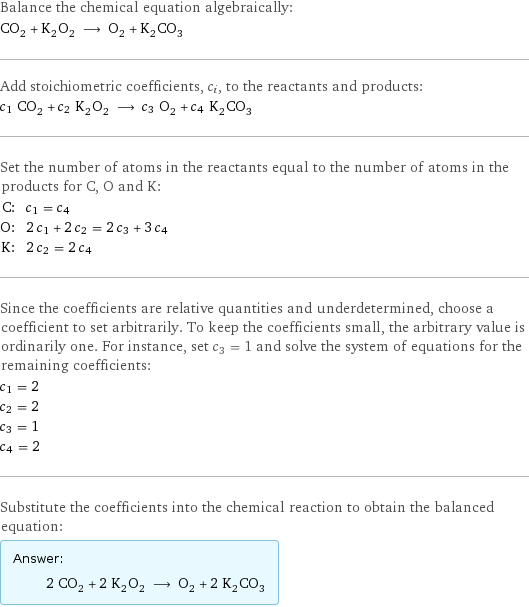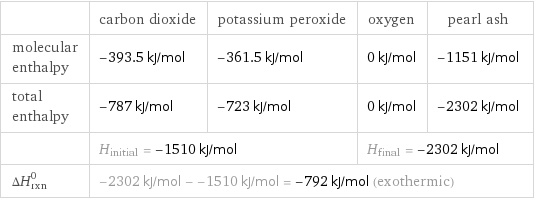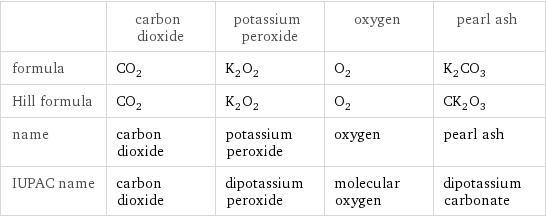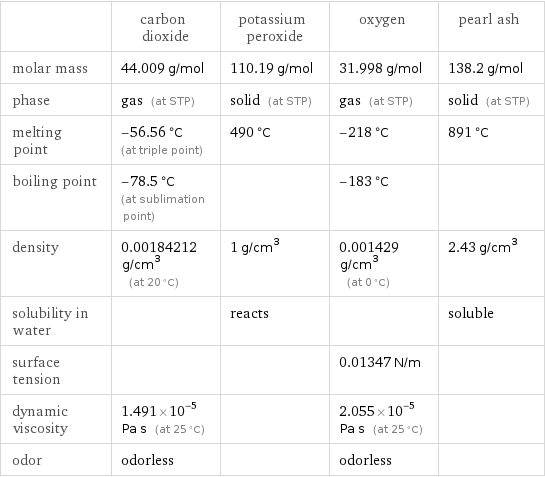Input interpretation

CO_2 carbon dioxide + K_2O_2 potassium peroxide ⟶ O_2 oxygen + K_2CO_3 pearl ash
Balanced equation

Balance the chemical equation algebraically: CO_2 + K_2O_2 ⟶ O_2 + K_2CO_3 Add stoichiometric coefficients, c_i, to the reactants and products: c_1 CO_2 + c_2 K_2O_2 ⟶ c_3 O_2 + c_4 K_2CO_3 Set the number of atoms in the reactants equal to the number of atoms in the products for C, O and K: C: | c_1 = c_4 O: | 2 c_1 + 2 c_2 = 2 c_3 + 3 c_4 K: | 2 c_2 = 2 c_4 Since the coefficients are relative quantities and underdetermined, choose a coefficient to set arbitrarily. To keep the coefficients small, the arbitrary value is ordinarily one. For instance, set c_3 = 1 and solve the system of equations for the remaining coefficients: c_1 = 2 c_2 = 2 c_3 = 1 c_4 = 2 Substitute the coefficients into the chemical reaction to obtain the balanced equation: Answer: | | 2 CO_2 + 2 K_2O_2 ⟶ O_2 + 2 K_2CO_3
Structures

+ ⟶ +
Names

carbon dioxide + potassium peroxide ⟶ oxygen + pearl ash
Reaction thermodynamics
Enthalpy

| carbon dioxide | potassium peroxide | oxygen | pearl ash molecular enthalpy | -393.5 kJ/mol | -361.5 kJ/mol | 0 kJ/mol | -1151 kJ/mol total enthalpy | -787 kJ/mol | -723 kJ/mol | 0 kJ/mol | -2302 kJ/mol | H_initial = -1510 kJ/mol | | H_final = -2302 kJ/mol | ΔH_rxn^0 | -2302 kJ/mol - -1510 kJ/mol = -792 kJ/mol (exothermic) | | |
Gibbs free energy

| carbon dioxide | potassium peroxide | oxygen | pearl ash molecular free energy | -394.4 kJ/mol | -425.1 kJ/mol | 231.7 kJ/mol | -1064 kJ/mol total free energy | -788.8 kJ/mol | -850.2 kJ/mol | 231.7 kJ/mol | -2127 kJ/mol | G_initial = -1639 kJ/mol | | G_final = -1895 kJ/mol | ΔG_rxn^0 | -1895 kJ/mol - -1639 kJ/mol = -256.3 kJ/mol (exergonic) | | |
Equilibrium constant
![Construct the equilibrium constant, K, expression for: CO_2 + K_2O_2 ⟶ O_2 + K_2CO_3 Plan: • Balance the chemical equation. • Determine the stoichiometric numbers. • Assemble the activity expression for each chemical species. • Use the activity expressions to build the equilibrium constant expression. Write the balanced chemical equation: 2 CO_2 + 2 K_2O_2 ⟶ O_2 + 2 K_2CO_3 Assign stoichiometric numbers, ν_i, using the stoichiometric coefficients, c_i, from the balanced chemical equation in the following manner: ν_i = -c_i for reactants and ν_i = c_i for products: chemical species | c_i | ν_i CO_2 | 2 | -2 K_2O_2 | 2 | -2 O_2 | 1 | 1 K_2CO_3 | 2 | 2 Assemble the activity expressions accounting for the state of matter and ν_i: chemical species | c_i | ν_i | activity expression CO_2 | 2 | -2 | ([CO2])^(-2) K_2O_2 | 2 | -2 | ([K2O2])^(-2) O_2 | 1 | 1 | [O2] K_2CO_3 | 2 | 2 | ([K2CO3])^2 The equilibrium constant symbol in the concentration basis is: K_c Mulitply the activity expressions to arrive at the K_c expression: Answer: | | K_c = ([CO2])^(-2) ([K2O2])^(-2) [O2] ([K2CO3])^2 = ([O2] ([K2CO3])^2)/(([CO2])^2 ([K2O2])^2)](../image_source/d841926510bb9a347900ca1da5aa31c8.png)
Construct the equilibrium constant, K, expression for: CO_2 + K_2O_2 ⟶ O_2 + K_2CO_3 Plan: • Balance the chemical equation. • Determine the stoichiometric numbers. • Assemble the activity expression for each chemical species. • Use the activity expressions to build the equilibrium constant expression. Write the balanced chemical equation: 2 CO_2 + 2 K_2O_2 ⟶ O_2 + 2 K_2CO_3 Assign stoichiometric numbers, ν_i, using the stoichiometric coefficients, c_i, from the balanced chemical equation in the following manner: ν_i = -c_i for reactants and ν_i = c_i for products: chemical species | c_i | ν_i CO_2 | 2 | -2 K_2O_2 | 2 | -2 O_2 | 1 | 1 K_2CO_3 | 2 | 2 Assemble the activity expressions accounting for the state of matter and ν_i: chemical species | c_i | ν_i | activity expression CO_2 | 2 | -2 | ([CO2])^(-2) K_2O_2 | 2 | -2 | ([K2O2])^(-2) O_2 | 1 | 1 | [O2] K_2CO_3 | 2 | 2 | ([K2CO3])^2 The equilibrium constant symbol in the concentration basis is: K_c Mulitply the activity expressions to arrive at the K_c expression: Answer: | | K_c = ([CO2])^(-2) ([K2O2])^(-2) [O2] ([K2CO3])^2 = ([O2] ([K2CO3])^2)/(([CO2])^2 ([K2O2])^2)
Rate of reaction
![Construct the rate of reaction expression for: CO_2 + K_2O_2 ⟶ O_2 + K_2CO_3 Plan: • Balance the chemical equation. • Determine the stoichiometric numbers. • Assemble the rate term for each chemical species. • Write the rate of reaction expression. Write the balanced chemical equation: 2 CO_2 + 2 K_2O_2 ⟶ O_2 + 2 K_2CO_3 Assign stoichiometric numbers, ν_i, using the stoichiometric coefficients, c_i, from the balanced chemical equation in the following manner: ν_i = -c_i for reactants and ν_i = c_i for products: chemical species | c_i | ν_i CO_2 | 2 | -2 K_2O_2 | 2 | -2 O_2 | 1 | 1 K_2CO_3 | 2 | 2 The rate term for each chemical species, B_i, is 1/ν_i(Δ[B_i])/(Δt) where [B_i] is the amount concentration and t is time: chemical species | c_i | ν_i | rate term CO_2 | 2 | -2 | -1/2 (Δ[CO2])/(Δt) K_2O_2 | 2 | -2 | -1/2 (Δ[K2O2])/(Δt) O_2 | 1 | 1 | (Δ[O2])/(Δt) K_2CO_3 | 2 | 2 | 1/2 (Δ[K2CO3])/(Δt) (for infinitesimal rate of change, replace Δ with d) Set the rate terms equal to each other to arrive at the rate expression: Answer: | | rate = -1/2 (Δ[CO2])/(Δt) = -1/2 (Δ[K2O2])/(Δt) = (Δ[O2])/(Δt) = 1/2 (Δ[K2CO3])/(Δt) (assuming constant volume and no accumulation of intermediates or side products)](../image_source/f9262c480e9f2ac878b55837f1ec1d90.png)
Construct the rate of reaction expression for: CO_2 + K_2O_2 ⟶ O_2 + K_2CO_3 Plan: • Balance the chemical equation. • Determine the stoichiometric numbers. • Assemble the rate term for each chemical species. • Write the rate of reaction expression. Write the balanced chemical equation: 2 CO_2 + 2 K_2O_2 ⟶ O_2 + 2 K_2CO_3 Assign stoichiometric numbers, ν_i, using the stoichiometric coefficients, c_i, from the balanced chemical equation in the following manner: ν_i = -c_i for reactants and ν_i = c_i for products: chemical species | c_i | ν_i CO_2 | 2 | -2 K_2O_2 | 2 | -2 O_2 | 1 | 1 K_2CO_3 | 2 | 2 The rate term for each chemical species, B_i, is 1/ν_i(Δ[B_i])/(Δt) where [B_i] is the amount concentration and t is time: chemical species | c_i | ν_i | rate term CO_2 | 2 | -2 | -1/2 (Δ[CO2])/(Δt) K_2O_2 | 2 | -2 | -1/2 (Δ[K2O2])/(Δt) O_2 | 1 | 1 | (Δ[O2])/(Δt) K_2CO_3 | 2 | 2 | 1/2 (Δ[K2CO3])/(Δt) (for infinitesimal rate of change, replace Δ with d) Set the rate terms equal to each other to arrive at the rate expression: Answer: | | rate = -1/2 (Δ[CO2])/(Δt) = -1/2 (Δ[K2O2])/(Δt) = (Δ[O2])/(Δt) = 1/2 (Δ[K2CO3])/(Δt) (assuming constant volume and no accumulation of intermediates or side products)
Chemical names and formulas

| carbon dioxide | potassium peroxide | oxygen | pearl ash formula | CO_2 | K_2O_2 | O_2 | K_2CO_3 Hill formula | CO_2 | K_2O_2 | O_2 | CK_2O_3 name | carbon dioxide | potassium peroxide | oxygen | pearl ash IUPAC name | carbon dioxide | dipotassium peroxide | molecular oxygen | dipotassium carbonate
Substance properties

| carbon dioxide | potassium peroxide | oxygen | pearl ash molar mass | 44.009 g/mol | 110.19 g/mol | 31.998 g/mol | 138.2 g/mol phase | gas (at STP) | solid (at STP) | gas (at STP) | solid (at STP) melting point | -56.56 °C (at triple point) | 490 °C | -218 °C | 891 °C boiling point | -78.5 °C (at sublimation point) | | -183 °C | density | 0.00184212 g/cm^3 (at 20 °C) | 1 g/cm^3 | 0.001429 g/cm^3 (at 0 °C) | 2.43 g/cm^3 solubility in water | | reacts | | soluble surface tension | | | 0.01347 N/m | dynamic viscosity | 1.491×10^-5 Pa s (at 25 °C) | | 2.055×10^-5 Pa s (at 25 °C) | odor | odorless | | odorless |
Units
